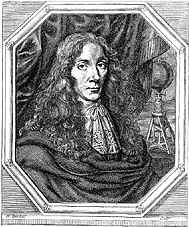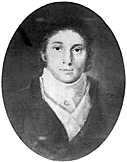

Philippus Aureolus Theophrastus Bomblast von Hohenheim called himself Paracelsus. (Born 1493 near Zurich, died 1541) He was an influential physician with controversial ideas and an argumentive personality. Paracelsus, an accomplished experimenter, added SALT to SULFUR and MERCURY as the tria prima, principles supplementing the 4 elements. Consistent with the ancient belief that the human body is a microcosm of the universe, he claimed preparing and purifying natural products for medical use is the true purpose of alchemy. Paracelsus subjected a large number of metals to a standardized set of reactions, thus obtaining a series of salts.
* Paracelsus for the first time generalized chemical reactions instead of considering every process as an individual treatment.
* By now Air had lost most of its importance as an Element. Paracelsus often called air chaos.
* Fire was now considered a combustible principle.
Sulfurrepresented this inflammable principle, the soul.* Mercury was the
wateror spirit.* Paracelsus made
Saltthe Earthly body.* Thus as an example, when wood burns, the part that really burns is the Sulfur, which vaporizes the Mercury, turning the ashes to
Salt.
Johannes Baptista van Helmont (b1577 in Brussels, d1644) believed water
essential to chemical changes. He grew a Willow tree for five years, showing that the 164 pound gain in tree's weight was only due to the added water since the soil's weight did not change!
Van Helmont coined the word gas to describe those mysterious wild spirits
which could neither be seen nor kept in vessels. He noted that gases from different sources are materials with different properties: gas carbonum from burning charcoal, gas sylvester from fermenting wine and spa water, inflammable gas pinque from organic matter, and another poisonous, red gas sylvester from some metals placed in aqua fortis. van Helmont derived gas
from the Greek word chaos
for empty space.

Johannes Joachim Becker (b1635, d1682) revised the four element/three principles theory of Paracelsus. He suggested that minerals are composed of three constituents: terra lapida (stone) giving body to substances, terra mercurialis (mercury) providing the properties of density and luster, and terra pinguis (fat) giving combustibility. When heated in air, metals loose terra pinguis into the air. The resulting calces are composed of terra mercurialis and terra lapida. Calcination
is the process of heating a substance in air. Calces
(Greek for ashes
) are the ores from which metals can be obtained.
Robert Boyle (b1627, d1691, shown at right→) criticized the FOUR ELEMENT THEORY and the THREE PRINCIPLES as not agreeing with the chemical facts.
Boyle requested chemists to review the experiments and devise a new theory. Boyle proposed a new definition of element: A substance that cannot be decomposed into any simpler substance. Boyle suggested the value of the ATOMIC THEORY of Democratus. He began studies of air that inspired others to later find inadequacies in the FOUR ELEMENT THEORY.
Georg Ernst Stahl (b1660, d1734) developed Becker's terra pinguis, terra mercurialis, and terra lapida. He renamed the inflammable terra pinguis, phlogiston. Like electricity, phlogiston cannot be isolated. However materials like charcoal, oils, and waxes are rich in phlogiston. Metals are compounds of phlogiston with their ores, calces. Heating calces with phlogiston rich charcoal restores the metal. Respiration and burning release phlogiston into the air, making phlogisticated air;
plants absorb phlogiston, restoring air. Stahl's phlogiston theory was the first systematic explanation of chemical reactions! Acceptance of the phlogiston theory coincided with a rapid accumulation of chemical facts.

Joseph Black (b1728, d1799, ←shown at left) in Edinburgh in 1754 found Magnesia alba
when effervesced with acids, or when calcinated, lost 7/12 of it weight, producing fixed air. (Thus he found that gas in a solid has weight.) Chalk (powdered marble) also lost weight when calcinated to form fixed air leaving a solid residue of quicklime. Black viewed quicklime as chalk minus fixed air rather than chalk plus phlogiston. In 1757 he demonstrated that burning charcoal also produces fixed air. Black showed this fixed air was distinctive, and not merely a variety of common air. He developed the limewater test for detecting fixed air.
On 1 August 1774, Joseph Priestly (b1733 in Yorkshire, d1804) used a 12 inch diameter burning glass to heat some red calx of mercury in an inverted glass sealed by a puddle of mercury, producing dephlogisticated air. In this gas a candle burned brightly, and a mouse lived over twice as long as in ordinary air. Between 1772 and 1777 Priestly identified seven distinct airs: nitrous air, muriatic acid air, alkaline air, diminished nitrous air, vitriolic acid air, dephlogisticated air, and nitrous acid vapour. Persecuted as nonconformist and sympathizer of the French Revolution, Priestly move to Pennsylvania in 1776.

Henry Cavendish (b1731, d1810) in 1766 distinguished inflammable air from fixed air by measuring their densities. He found that inflammable air
react with nearly 1/5 of common air, producing a small amount of pure water. Exploding 1 volume of "dephlogisticated air" with 2 volumes of "inflammable air" consumes both, making only water!
Daniel Rutherford (b1749, d1819) in 1772 removed fixed air from air previously used for breathing or burning to find a residue of noxious air.
Carl Wilhelm Scheele (b1742 at Stralsund Sweden, d1786, shown at right→) in 1770 produced inflammable air (he thought it to be pure phlogiston) by treating zinc with an organic acid. By 1773 (but not published until 1777) he heated silver carbonate, producing what he named Feuerluft (German meaning fire air, what Priestly later called dephlogisticated air). He showed this gas was identical with lost air absorbed from ordinary air by rusting iron or burning phosphorus. Scheele also discovered the substances we now call chlorine, hydrofluoric acid, silicon fluoride, arsine, arsenic acid, prussic acid, manganates, permanganates, glycerol, and tartaric, citric, lactic, and oxalic acids.
![]()
Consider the diverse vocabulary for the substances which Alchemists decided were distinct substances. Note that they attempted to name each substance with terms which were understandable based on the Four Element and Phlogiston Theory. But these terms are confusing based on our current theory. Vocabulary tends to tie one's thinking to a particular theoretical way of viewing reality. The next page notes that Antoine Lavoisier thought this so important that he insisted on re-naming many substances: For example, Dephlogisticated air became Oxygen (meaningacid forming) and phlogiston became Hydrogen (meaningwater forming). Perhaps consider how this connection between vocabulary and theory extends to other aspects of our perception such the implied meanings of right wing politics and fundamental religious doctrine.


| introduction | Greeks | alchemy | ↑ | Lavoisier | Dalton | Berzelius | molecules | spectra | electron | radiation | Bohr | isotopes | synthesis |
| to site menu | Discovery and Naming of Chemical Elements |
chemistry | physics | ||||||||||
| created 23 March 2002; additions 20 May 2003 latest revision 26 April 2010 |
by D Trapp | ||||||||||||